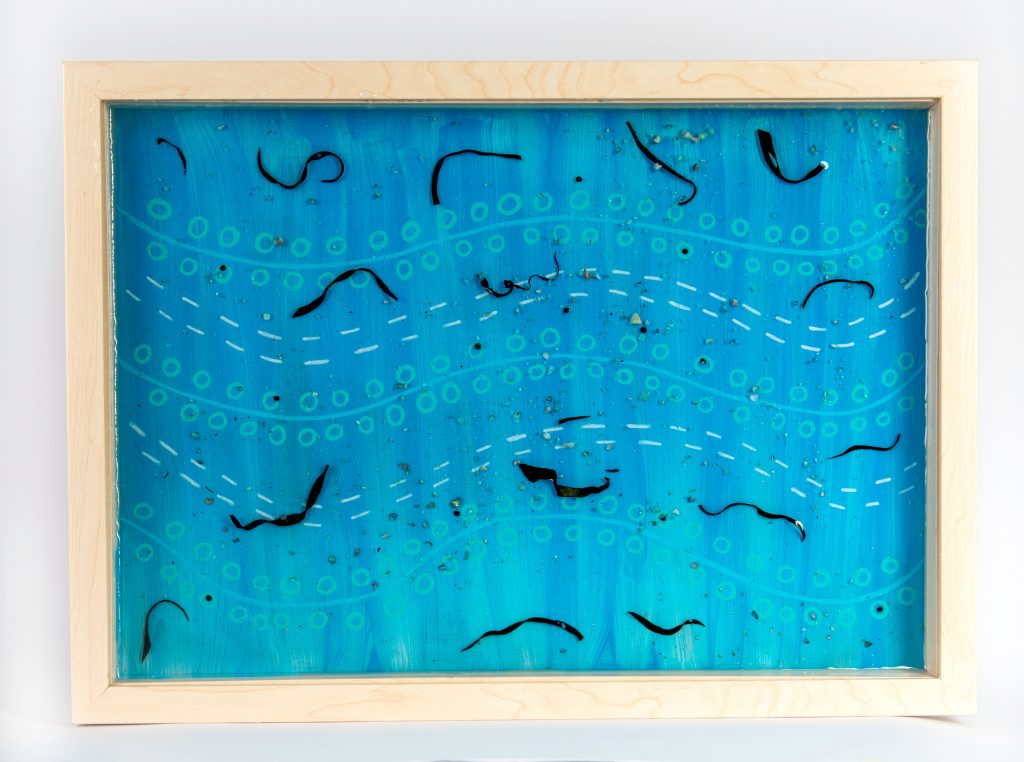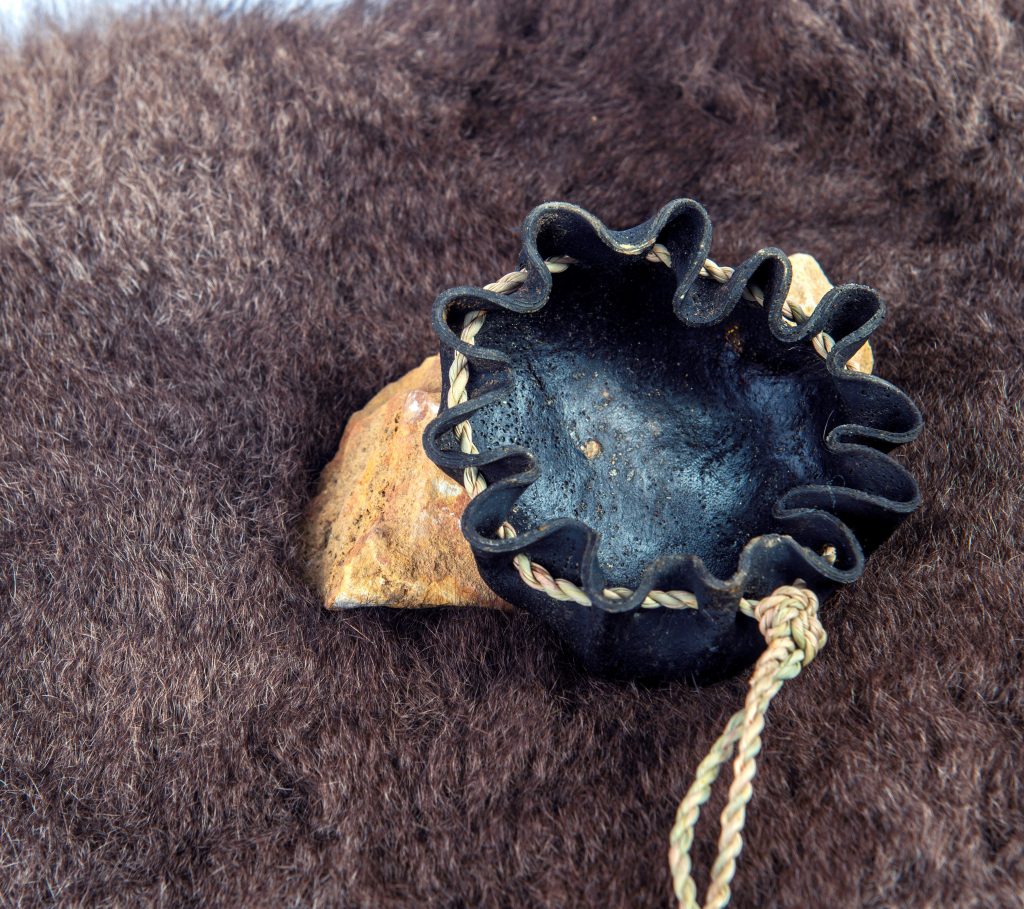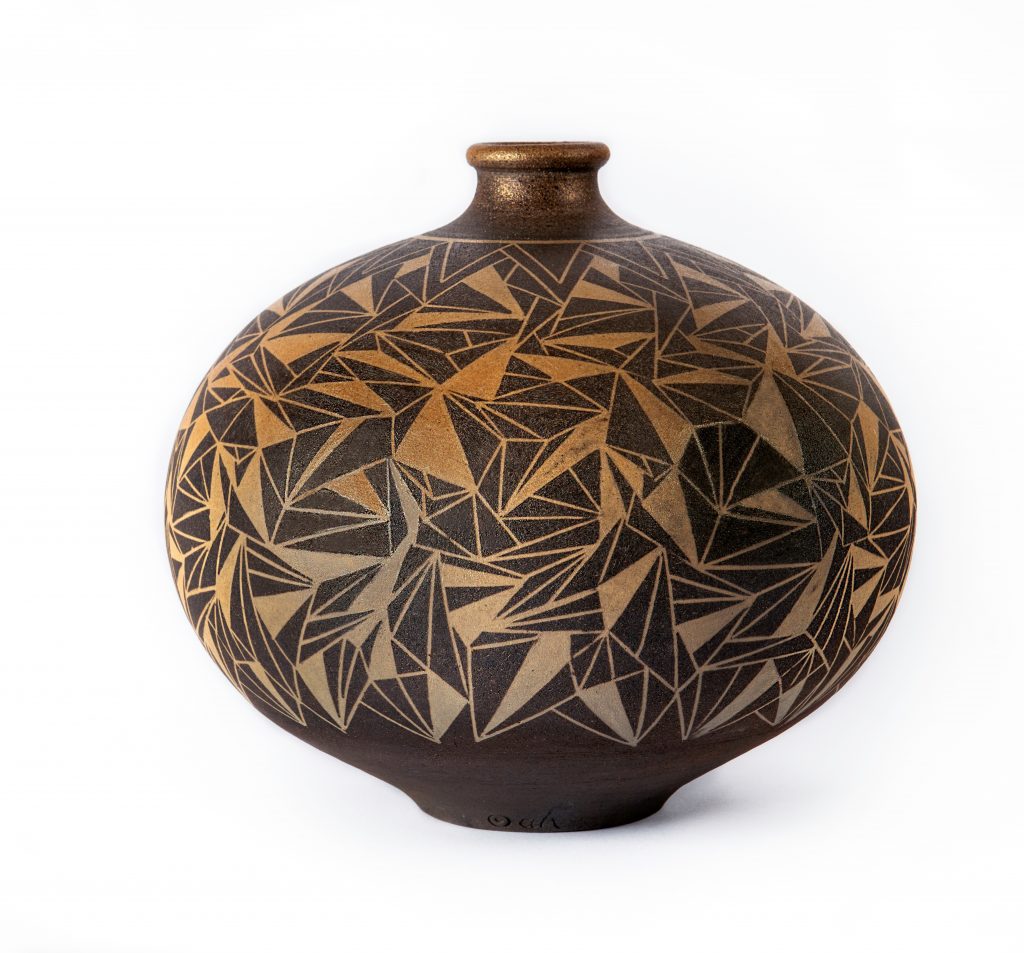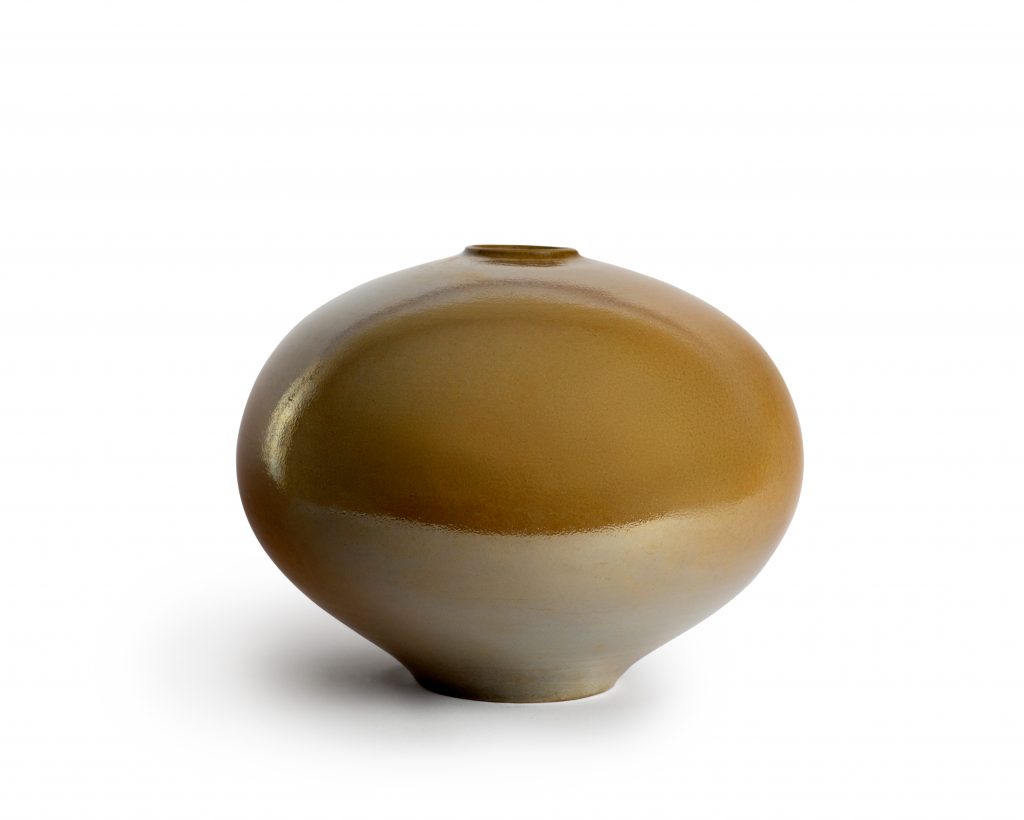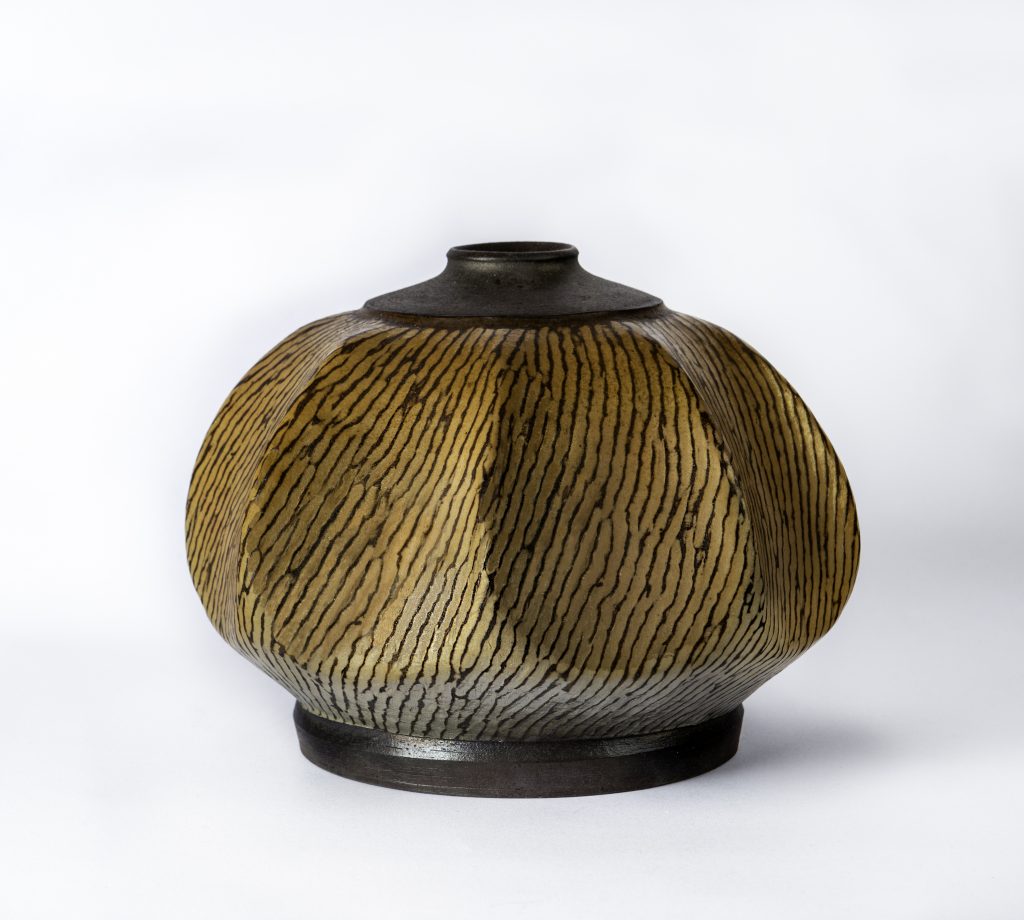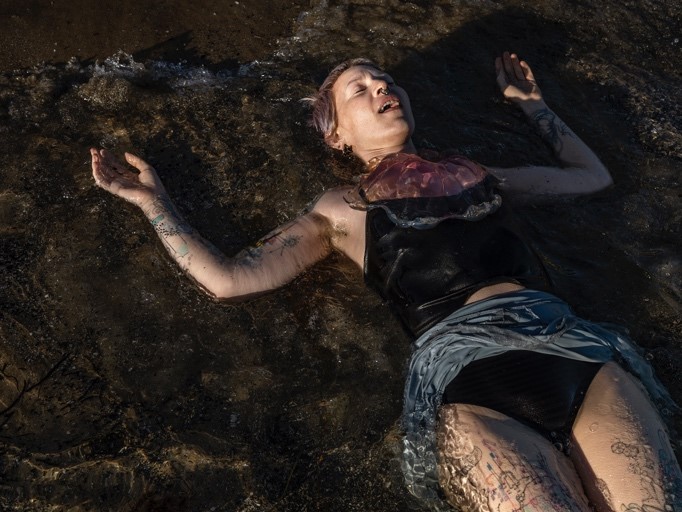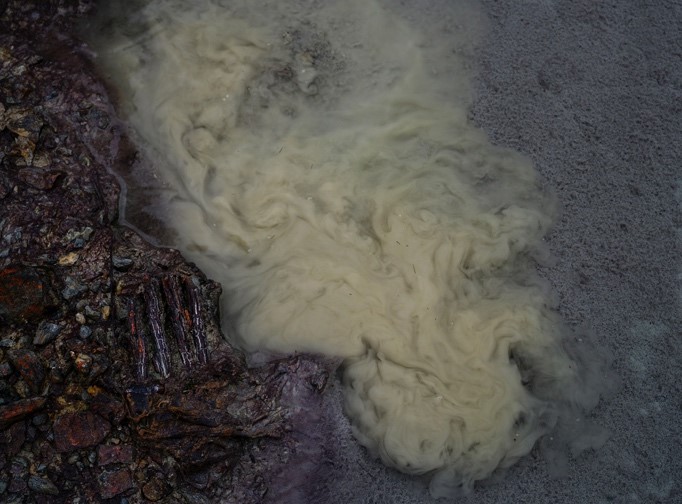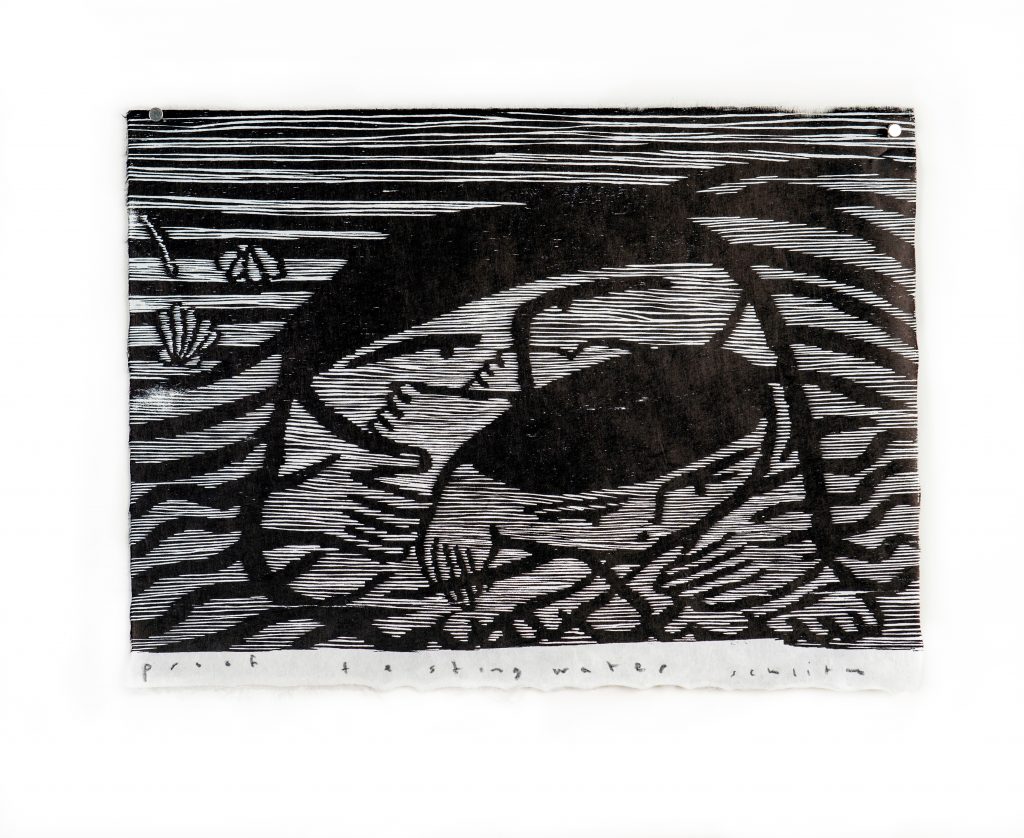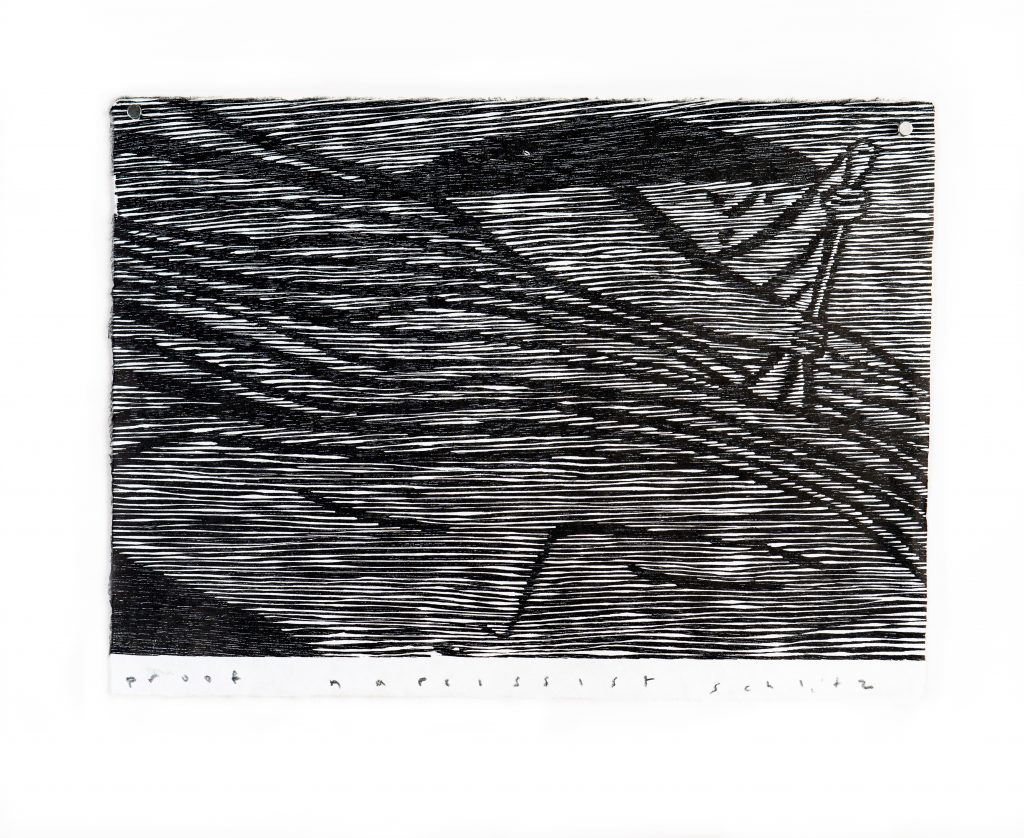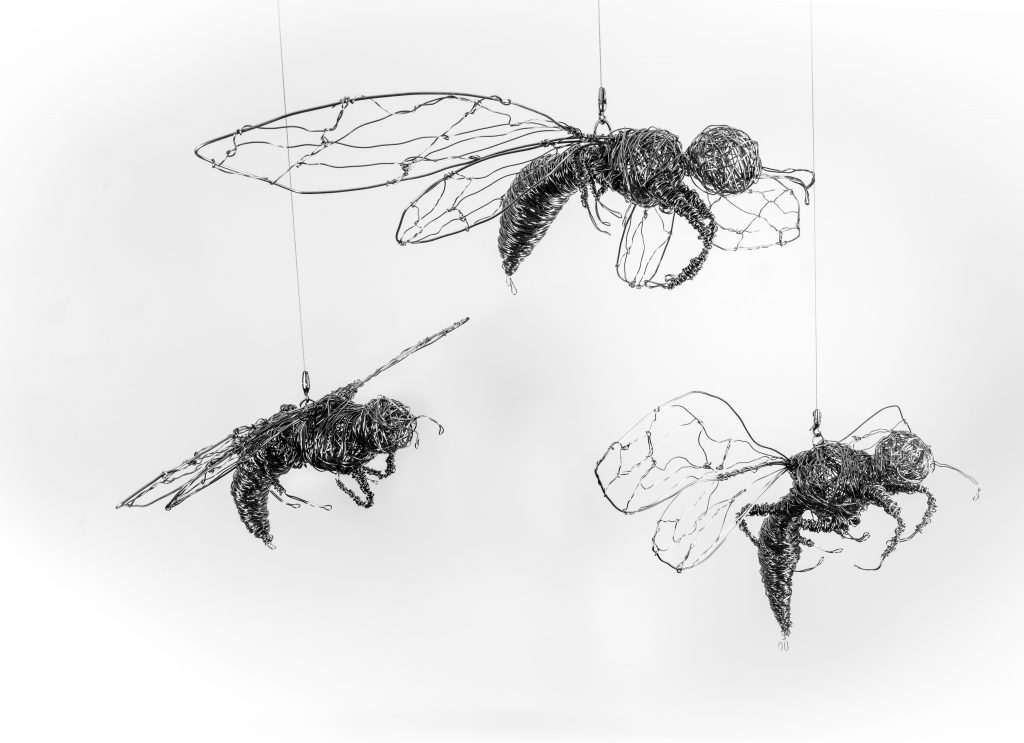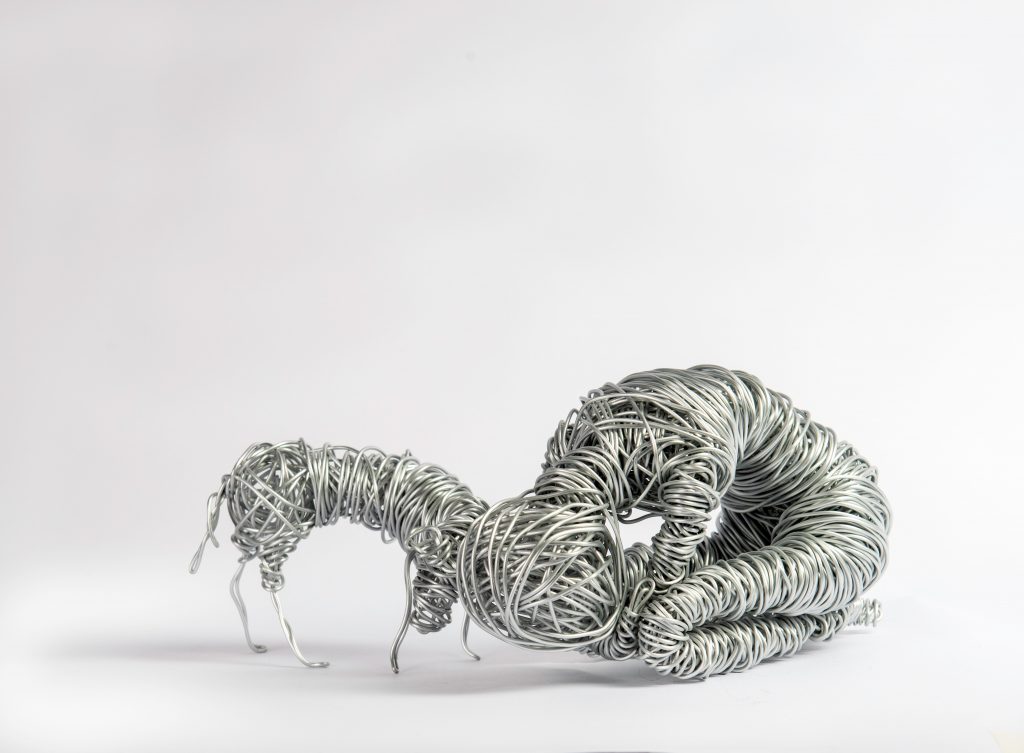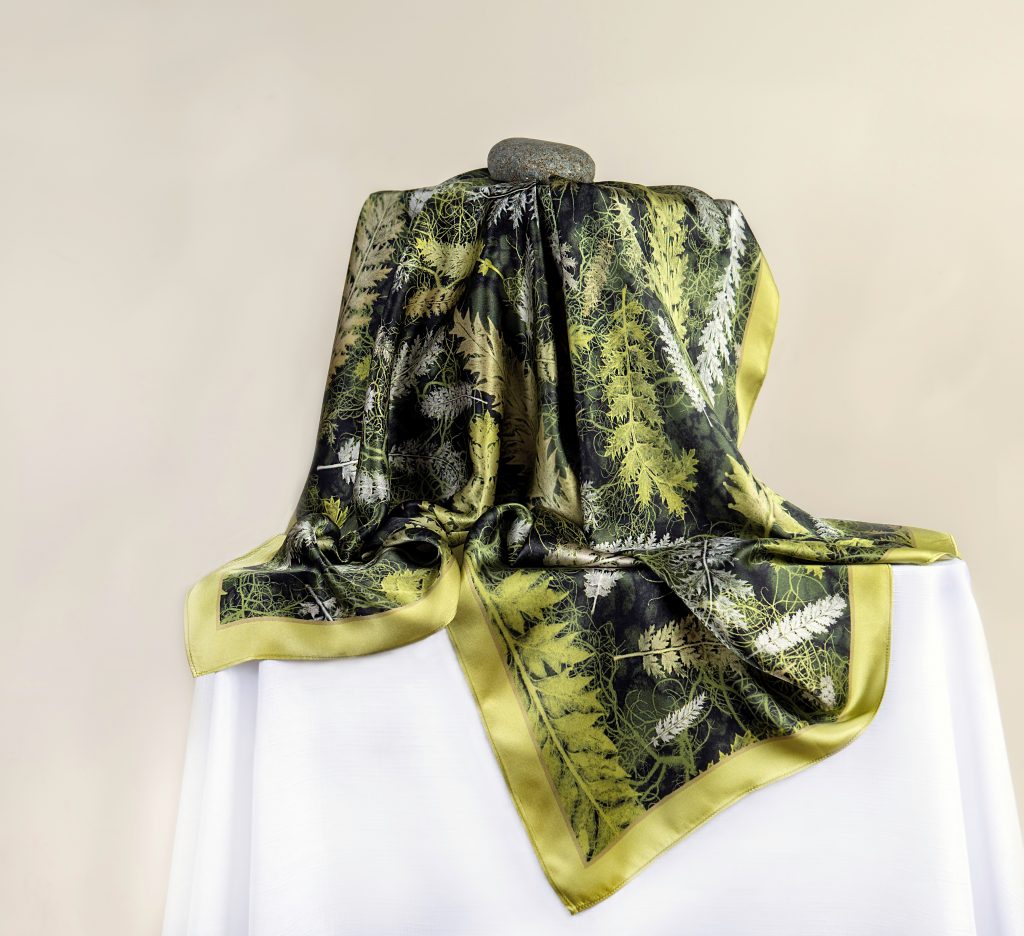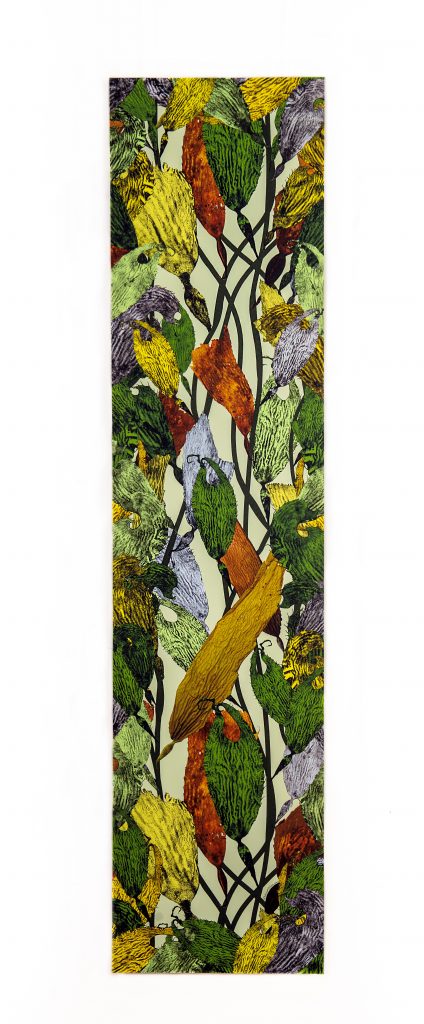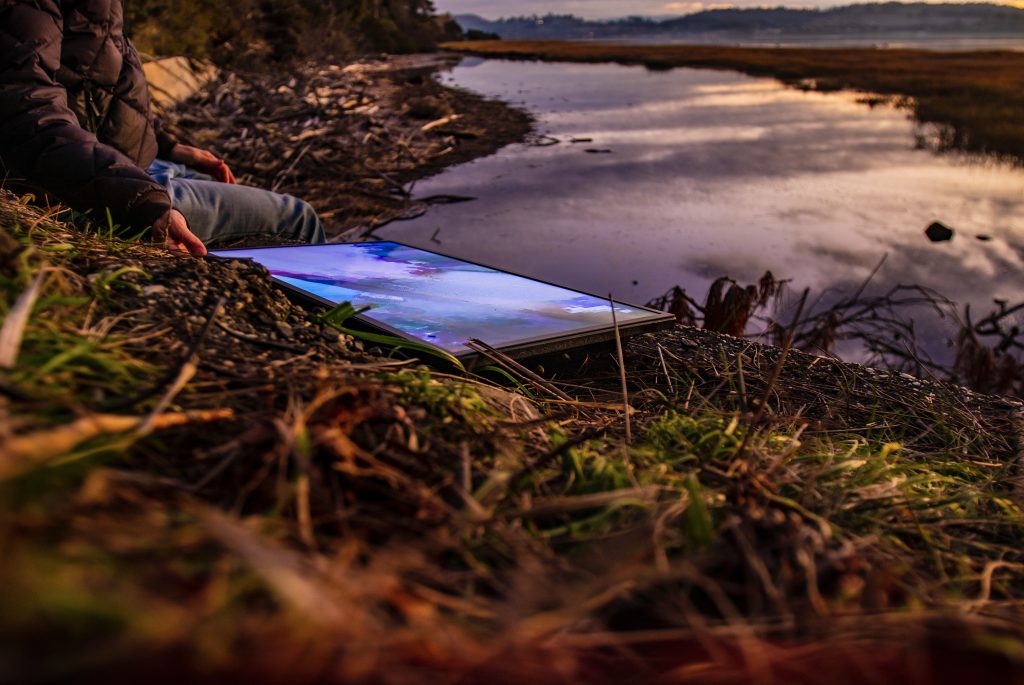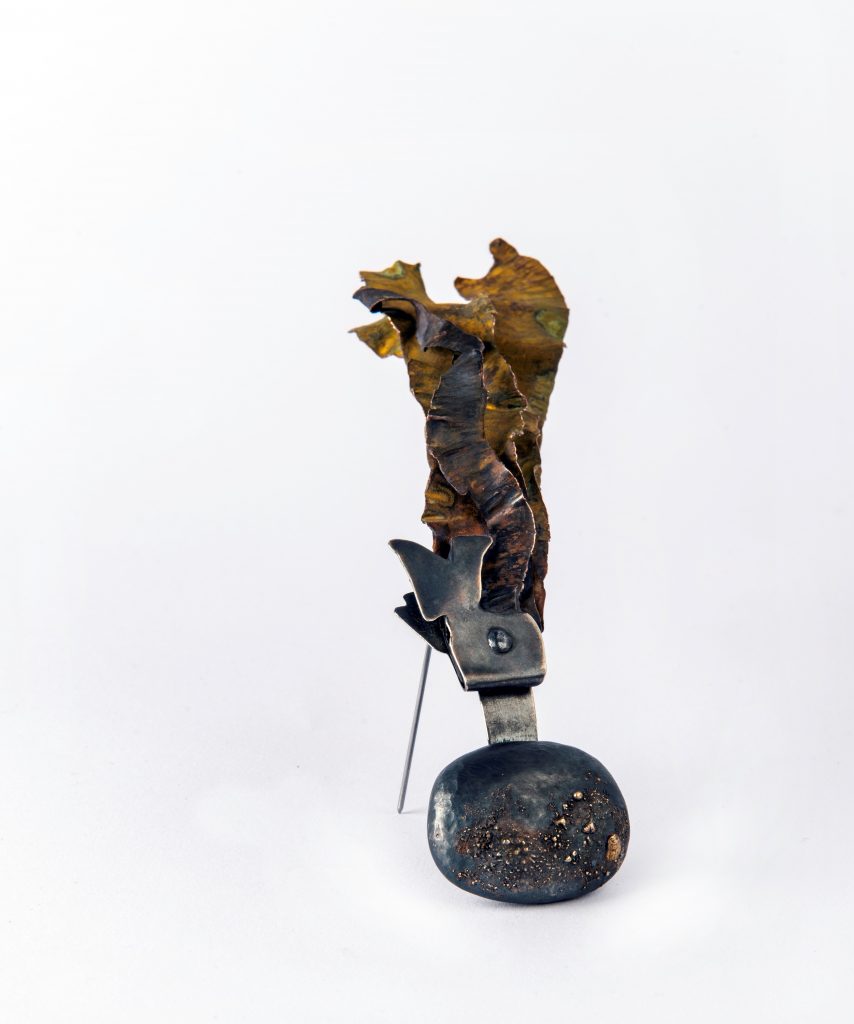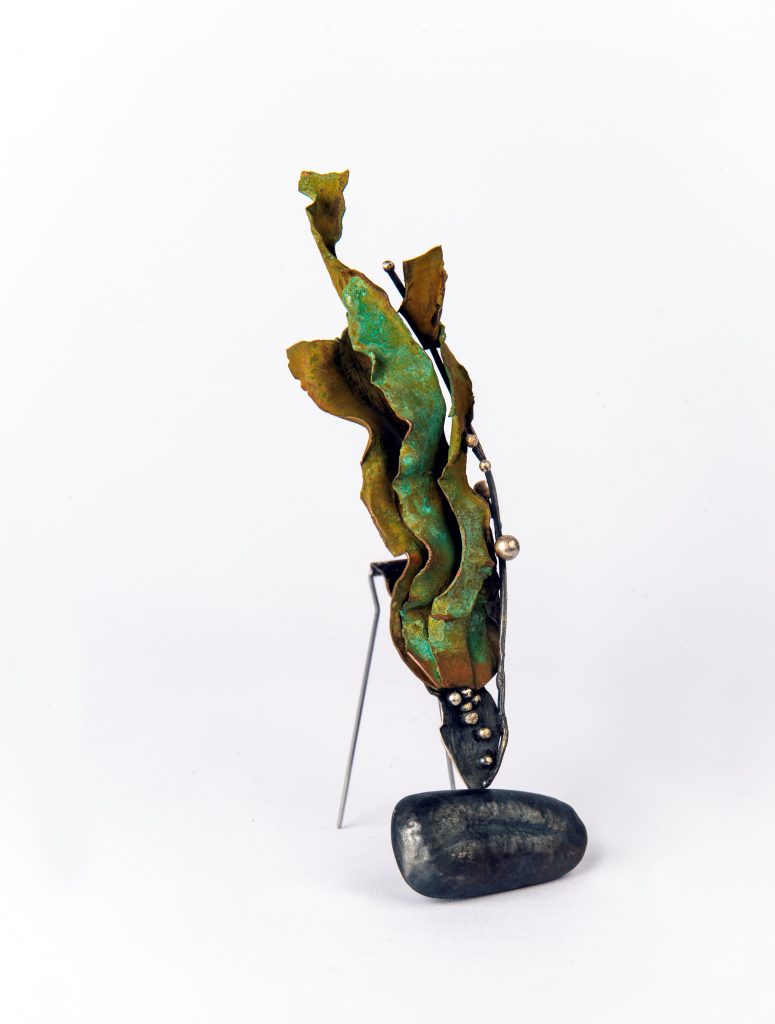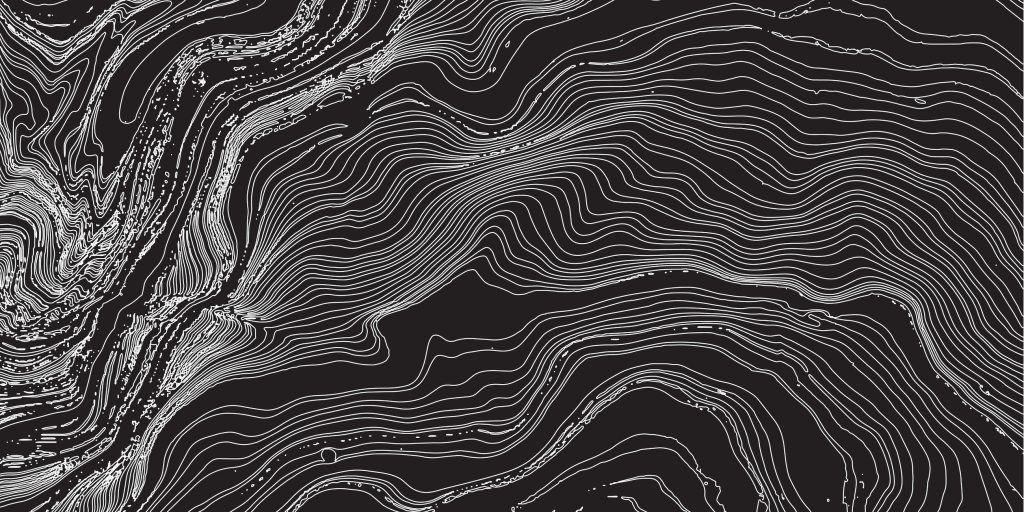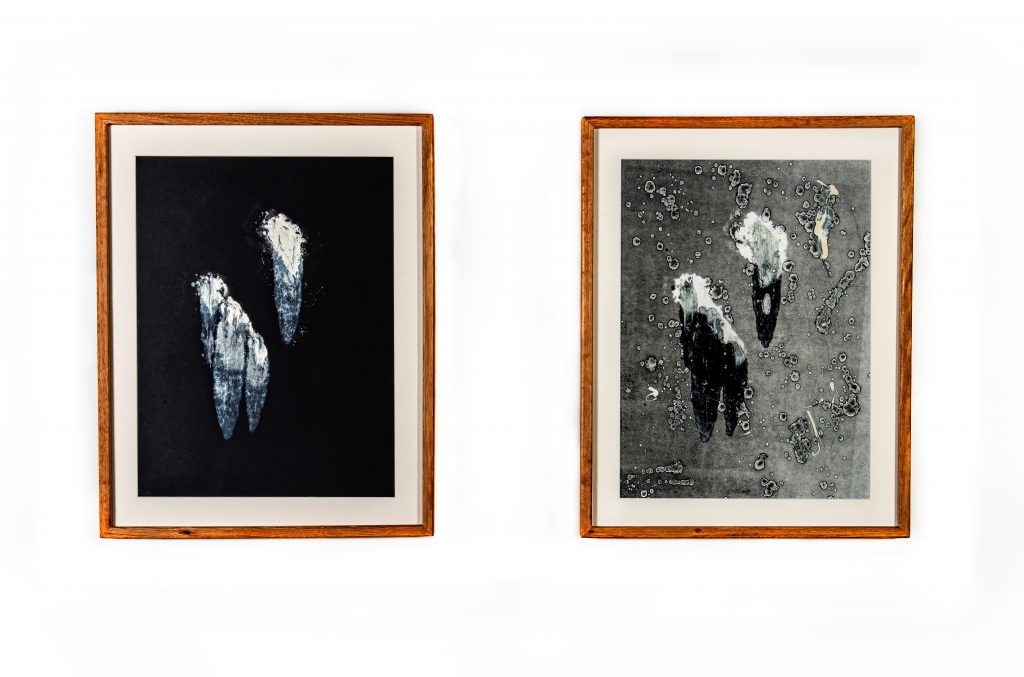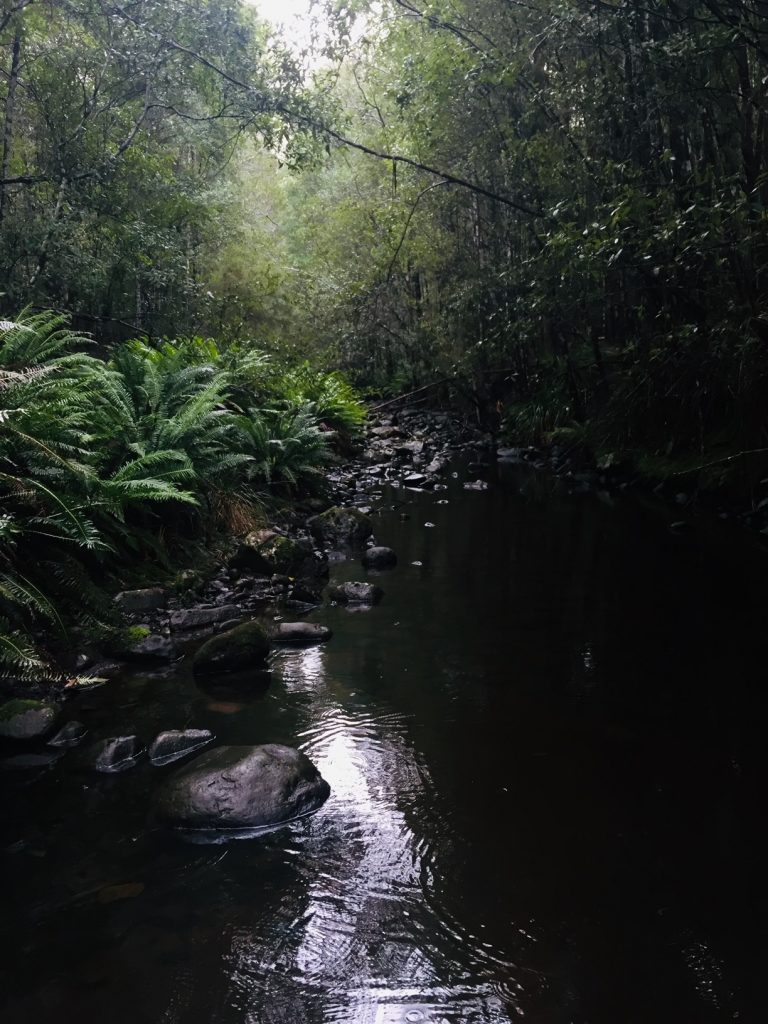We are proud to showcase our talented Huon Valley and Launceston-based artists as part of this collaborative exhibition, ‘Flow‘.
Read on to learn more about the participating artists and the inspiration behind their works.
Bianca Templar
‘Flow’, a word defined as “the action or fact of moving along in a steady, continuous stream” when spoken, but when imaged it goes beyond the textbook definition.
The painting is my visual representation of ‘Flow’. It represents that flow of the water and the movement of kelp and seashells within its depth. Both pieces have been named ‘Flow’, as each one represents as element of water.
Bianca Templar is a proud Palawa women from Lutruwita (Tasmania), whose family descends from Cape Barren Island, descendants of the Trawlwoolway people. Bianca grew up watching her grandmother, Aunty Gloria Templar, shell string and weave, peaking her interest in cultural arts.
Bianca’s upbringing has been filled with various arts, with her father being a poet and theatre performer, her brother being a portrait artist and guitarist and her nan being a cultural artist.
Over the last four years Bianca began shell stringing, weaving and kelp basket making, as well as learning how to paint utilising the Tasmanian Aboriginal petroglyphs and resin art. This has led Bianca to do a variety of different shows and exhibitions such as Junction Arts in 2021, Sawtooth ARI galleries 2021 and 2022 NAIDOC exhibitions and Cultivate 2022.
To view more of Bianca’s works, visit:
Facebook: https://www.facebook.com/Takamunamunarrala
Instagram: https://www.instagram.com/bianca_templar__takamuna_rrala
Andrew Halford
The basis of my training comes from the Japanese Mingei philosophy which is to create beauty in everyday objects and to ensure their functionality. This philosophy was reinforced through the constant practice of technical skills so that they live in the muscle memory.
Over the years you no longer need to think about what your hands are doing. You can let the creative force flow from the eyes to the heart to the hands to the clay. Part of the discipline of learning and constant refining of these techniques means you can let the clay live and reveal its own nature – to be naturally free.
I retain respect for the material and the earthly powers that made it. I use soft clay which has its own sensitivity versus hard clay. I resist dominating the clay and forcing it into a pattern and shape it seems to be resisting. The product has more natural freedom about it.
Soft clay contains more water. Water is an important element of my life and I constantly draw inspiration from it. I’ve always lived by the water. I sail, I fish, I observe.
Andrew Halford commenced formal training as a potter from sixteen years of age. Andrew was first apprenticed to Shiga Shigeo (Sydney) and then to Les Blakeborough (Sturt Workshops, Mittagong) followed by a five-year stint in Japan first with Shimaoka Tatsuzo (Living National Treasure) and then with Shimada Haruo making traditional large coiled and thrown vessels.
Andrew’s career has been marked by highlights such as his work being collected by the National Gallery, Canberra and most state-based galleries including the Powerhouse Museum. Andrew has had several shows at the Potters Society Gallery in Sydney; he is shown at the Craft Centre in Melbourne and more recently at the MCCA Gallery in Mashiko, Japan.
His work is currently on display at the Museum of Applied Arts and Sciences. His approach to his ceramics is underpinned by his lifestyle and philosophy of living in harmony with nature. He continues to refine his skills to represent this harmony.
To view more of Andrew’s works, visit:
Sarah Rhodes
Like a Murakami novel, Sarah Rhodes’ photographic series, A Surrounded Beauty, conjured a dream-like world, where people and place are disparate yet connected at the same time. Although they all appear to be weaving different threads, their stories are woven into one. While making this work, it was a person’s aura and the affective capacity of place that Rhodes was drawn to – something she could feel, but could not quite put into words.
lutruwita/Tasmania has generated many myths in the minds of mainlanders; its remoteness and wilderness have become both awe-inspiring and fearsome. But to Rhodes, there’s something that links these islanders beyond their distinct Southern axis, and across these photographs we are invited to journey alongside her in the discovery. For it is something in these faces, these stories and these landscapes that Rhodes connects to; she sees something in them that she recognises within herself. As a child of parents born and raised on the South Island of Aotearoa/New Zealand, Rhodes is attracted to those she sees as possessing a kind of resilience, learnt through the circumstances of island-isolation. Rhodes believes that her subjects, through isolation, have embodied the landscapes in which they live and in turn, these landscapes reflect back what is within them.
To view more of Sarah’s works, visit:
Michael Schlitz
In my practice I try to get the most out of a few simple ideas. Most of my woodcuts are made with this philosophy in mind. For example, I draw onto the wood with ink then use one tool to cut straight lines that follow the grain of the wood. I bring the image into being by cutting the space around what I’ve drawn. The process of cutting the woodblock is very much like a flow of continuous movement of one tool following the grain in the negative space of the ground.
Michael Schlitz is represented by Bett Gallery, Hobart.
BETT GALLERY
nipaluna/Hobart
Level 1 / 65 Murray Street
Hobart TAS 7000
T: +61 (0) 3 6231 6511
General enquiries: info@bettgallery.com.au
Louise Daniels
Louise Daniels is a Trawlwoolway Palawa woman of lutruwita (Tasmania), born and raised in Ulverstone on the state’s north west coast, where she currently lives and has her art practice.
Daniels loves to draw, paint and make things with her hands, and her current art practice utilises all these elements with landscape paintings, charcoal drawings and figurative wire sculpture. She has recently been drawing Country with found charcoal, ochres and paint. Her sculpture can be light hearted or serious, and often captures everyday moments in the human and animal world. Her wire sculpture is held in public and private collections in Australia and overseas.
Daniels holds a Bachelor of Contemporary Arts with Honours degree awarded by the University of Tasmania in 2019. She is also a published researcher whose recent studies and many of her artworks continue her research and exploration of the experiences of her Palawa ancestors who endured the brutal colonisation of Tasmania in the early nineteenth century.
To view more of Louise’s works, visit:
Deborah Wace
My arts practice is a constant search for, and immersion in flow. Through art, fabric, and song. I find when I am in the creative state, a deep and nourishing mental space opens where I am full of contemplation, wholly engaged with the task at hand. A productive sense of wellbeing and intensity holds me, and I am caught in the flow of the creative moment. I am extremely grateful for this access into timeless moments – through my plant study in the wild and my studio printmaking and microscope drawing explorations.
As an activist/artist my artwork and fabric design are driven by my desire to educate about Tasmania’s biodiversity, rich environmental values, unique and threatened species, and its botanical history. I advocate for protection of Tasmania’s wild and endangered flora and telling of the stories which accompany them. lutruwita is the landscape that supports my art.
When out walking, I tune my eye for the plant that I am studying, scanning, choosing. Suddenly another form catches my eye and I look down and through layer on layer of diversity to the ferns and orchids a few inches high. Macro to micro is a deeply fulfilling and mesmerising, flow zone.
Deborah Wace is a botanical artist, fabric designer and professional printmaker from Tasmania. Through her highly detailed and intimate artwork she creates a window into the botany of Tasmania’s wild and often endangered plant communities including native orchids, rainforest, buttongrass and marine plants.
Deborah’s inspiration for her range is drawn from her extensive, private plant specimen collection, gathered and digitised over 30 years. She combines digital plant images with dry point and mono-print original artwork and etchings, which she layers to create her rich, complex botanical designs on fine fabric, wallpaper and a range of architectural substrates. She is embedding plant specimen collection, production, and printing processes into her work.
To view more of Deborah’s works, visit:
Facebook: https://www.instagram.com/deborahwace/
Instagram: https://www.facebook.com/deborahwacebotanicalartist/
Joanne Faulkner
Joanne Faulkner’s work focuses on the embodied and entwined nature of human, more-than-human and digital spaces. Through her practice, Faulkner seeks to form a relationship with her environment that is grounded in and sustained by respect and reciprocity.
The video ‘for kanamaluka’ was made with and for kanamaluka/the Tamar River. A flow of tactile impressions, dissolving and resolving along kanalamuka’s lengths, the video was eventually returned and shown to the river.
Faulkner graduated with a Bachelor of Fine Arts from Monash University and has exhibited in various galleries around Melbourne. Since 2015 she has lived and worked in lutruwita on the unceded lands of the Palawa people where she has been combining digital photography, video, and installation to explore and participate in the local landscape.
To view more of Joanne’s works, visit:
Instagram: https://www.instagram.com/hellofotojo
Natasa Milenovic
Having the privilege to live close by the intertidal zone and observing throughout the seasons the washed-up treasures of the underwater world, I realised little do I know. Particularly the seaweeds stuck to little rocks inspired and intrigued me, perfect compositions of natures’ design.
Reading up on it, I found out that seaweeds just do that – anchor themselves onto rocks, and it has a lovely name called “holdfast”. Even being a seaweed, it is attaching in order to grow. It doesn’t take in nutrients from the roots as such – but that is another story.
I can totally relate within my human existence and had an epiphany, or a confirmation – we all need to feel grounded and secure to be able to get in a state of flow and grow.
Natasa Milenovic is a German trained goldsmith based in Cygnet and specialises in small edition and custom jewellery.
Her pieces are intuitive interpretations of fungi, lichen and seaweed.
She utilises traditional techniques such as forging, fusing and soldering in a contemporary way and pairs precious and base metals side by side. Surface treatments with patinas are often applied for splashes of colour, contrast and texture.
Natasa’s work has been represented in local and interstate galleries and she has participated in group exhibitions since she immigrated to Tasmania in 2001. She received funding from the Duisburg Gesellschaft to work in Australia as a jewellery maker in 2000 and from the Australian Council of the Arts for New Work in 2006 which resulted in her solo exhibition Hidden.
To view more of Natasa’s works, visit:
Facebook: https://www.facebook.com/natasamilenovic.studio
Instagram: https://www.instagram.com/natasamilenovic_studio/
Emma Magnusson-Reid
Suminigashi is the Japanese marbling art form originating from the 12th century. Using a vessel containing water, ink is lightly applied to the surface with a brush. Floating on the water, the ink swirls and moves in relation to the air and your breath that surrounds it. It is impossible to control the pattern. Then, carefully you capture the impression of the ink and water by swiftly applying a thin rice paper or silk.
‘wood, wind, water’ is a translation of my suminigashi marks onto a woodblock where I can recreate the design and produce multiple iterations through the printing process.
There is an inherent flow with printmaking, each step informing the next; from designing the image, to preparing your block or ‘plate’ and then finally, the process of applying ink to print your images either by hand or by using a press.
My work is exploring the concept of ‘flow’, through the materiality and innate qualities and elements used that both the suminigashi and printmaking processes give.
Emma Magnusson-Reid was born in the north-west of Tasmania where she was raised on a rural property. She graduated with a Bachelor of Fine Art in 2017 in Hobart and achieved First Class Honours in 2020, UTAS, Launceston.
Emma received the Salamanca Arts Centre’s Inaugural Emerging Arts Scholarship in 2017 and since has exhibited statewide, tutored in various institutions, and is currently the printmaking technician at the Academy of Arts, UTAS.
In 2021 she presented her solo exhibition ‘From the Womb to the Tomb‘ at the Burnie Regional Art Gallery. Emma lives and performs her arts practice from Beechford in the nort-east of Tasmania.
To view more of Emma’s works, visit:
Instagram: https://www.instagram.com/theflowerthief
Eden Meure
My connection to the Huon is one of transition and flow. My father’s family migrated to the Huon Valley in 1954 from the Netherlands on the ship Volendam. I was born in a family home in Glen Huon just before the primary school. Growing up I spent many summers with that family swimming in the Huon River down by the mushroom farm. My father being very fond of the water and sailing, would take us on many trips through the Derwent in different vessels. These sound works are collected field recordings of the flowing Huon River, the water’s edge of the Derwent Estuary; two major bodies of water flowing, lapping, streaming as they connect.
Each sound work is composed from different ends of the connected waterways, drawing together history, geography, language, electrical and physiological soundscapes. The two works come together as do the two flowing bodies of water which connect the Central Highlands to the most southern point of Tasmania, running through the centre like a bloodline.
Eden Meure is a multi-disciplinary artist living and working in lutruwita/Tasmania with a focus on experimental sound, performance and moving image.
My intention in these works is to capture and collect sounds of my experience living in Tasmania and having a strong connection with the flow of our landscape and most importantly, the flow of our waterways. The water that not only surrounds our beautiful state but also runs through it has many deep connotations to the history of this place as well as our relation as humans to it. By making two works, I attempt to merge the collection of sounds from two waterways and interconnect them along with sounds that exhibit ways in which we use these bodies of water as a collective.
To view more of Eden’s works, visit:

